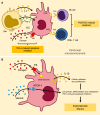Immune pathway through endometriosis to ovarian cancer
- PMID: 38689629
- PMCID: PMC11056862
- DOI: 10.5306/wjco.v15.i4.496
Immune pathway through endometriosis to ovarian cancer
Abstract
Endometriosis is an estrogen-dependent inflammatory disease, defined by the presence of functional endometrial tissue outside of the uterine cavity. This disease is one of the main gynecological diseases, affecting around 10%-15% women and girls of reproductive age, being a common gynecologic disorder. Although endometriosis is a benign disease, it shares several characteristics with invasive cancer. Studies support that it has been linked with an increased chance of developing endometrial ovarian cancer, representing an earlier stage of neoplastic processes. This is particularly true for women with clear cell carcinoma, low-grade serous carcinoma and endometrioid. However, the carcinogenic pathways between both pathologies remain poorly understood. Current studies suggest a connection between endometriosis and endometriosis-associated ovarian cancers (EAOCs) via pathways associated with oxidative stress, inflammation, and hyperestrogenism. This article aims to review current data on the molecular events linked to the development of EAOCs from endometriosis, specifically focusing on the complex relationship between the immune response to endometriosis and cancer, including the molecular mechanisms and their ramifications. Examining recent developments in immunotherapy and their potential to boost the effectiveness of future treatments.
Keywords: Endometriosis; Endometriosis-associated ovarian cancers; Immune response; Immunotherapy; Ovarian neoplasms.
©The Author(s) 2024. Published by Baishideng Publishing Group Inc. All rights reserved.
Conflict of interest statement
Conflict-of-interest statement: All authors declare no conflicts of interest regarding the publication of this manuscript.
Figures





Similar articles
-
Endometriosis-associated ovarian cancer: a review of pathogenesis.Int J Mol Sci. 2013 Mar 6;14(3):5367-79. doi: 10.3390/ijms14035367. Int J Mol Sci. 2013. PMID: 23466883 Free PMC article.
-
Endometrial cancer with concomitant endometriosis is highly associated with ovarian endometrioid carcinoma: a retrospective cohort study.BMC Womens Health. 2022 Aug 5;22(1):332. doi: 10.1186/s12905-022-01917-5. BMC Womens Health. 2022. PMID: 35932070 Free PMC article.
-
The recent progress and therapy in endometriosis-associated ovarian cancer.J Chin Med Assoc. 2020 Mar;83(3):227-232. doi: 10.1097/JCMA.0000000000000262. J Chin Med Assoc. 2020. PMID: 31985569 Review.
-
Endometriosis-associated ovarian carcinomas: insights into pathogenesis, diagnostics, and therapeutic targets-a narrative review.Ann Transl Med. 2020 Dec;8(24):1712. doi: 10.21037/atm-20-3022a. Ann Transl Med. 2020. PMID: 33490224 Free PMC article. Review.
-
The "Road" to Malignant Transformation from Endometriosis to Endometriosis-Associated Ovarian Cancers (EAOCs): An mTOR-Centred Review.Cancers (Basel). 2024 Jun 6;16(11):2160. doi: 10.3390/cancers16112160. Cancers (Basel). 2024. PMID: 38893278 Free PMC article. Review.
References
-
- Barreta A, Sarian L, Ferracini AC, Eloy L, Brito ABC, de Angelo Andrade L, Derchain S. Endometriosis-Associated Ovarian Cancer: Population Characteristics and Prognosis. Int J Gynecol Cancer. 2018;28:1251–1257. - PubMed
-
- Fuldeore MJ, Soliman AM. Prevalence and Symptomatic Burden of Diagnosed Endometriosis in the United States: National Estimates from a Cross-Sectional Survey of 59,411 Women. Gynecol Obstet Invest. 2017;82:453–461. - PubMed
-
- Nnoaham KE, Hummelshoj L, Webster P, d'Hooghe T, de Cicco Nardone F, de Cicco Nardone C, Jenkinson C, Kennedy SH, Zondervan KT World Endometriosis Research Foundation Global Study of Women's Health consortium. Impact of endometriosis on quality of life and work productivity: a multicenter study across ten countries. Fertil Steril. 2011;96:366–373.e8. - PMC - PubMed
Publication types
LinkOut - more resources
Full Text Sources

